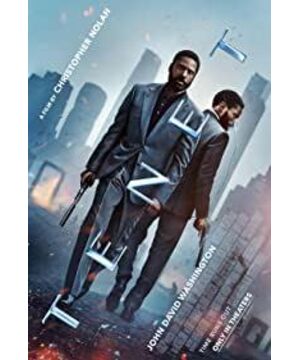Text/evarnold 2020.9.12
This is the second film review of "Creed". There are three reasons for writing it:
One is the previous film review, almost half of the comments "you didn't understand". I am a Scorpio, and I want to open a new place where people are stunned and stunned.
The second is that my first film review was ranked second in the hot review, but I am not satisfied with it.
Third, Nolan is indeed very important to me, and there is still a lot to say.
This article wants to discuss the following issues:
1. What is the consistent theme of Nolan's movies?
2. Is Nolan a master of action?
3. How much is the bonus for real-time shooting, IMAX2D, film, sound-effect music, and cross-editing?
4. How do you think about the "brain burning" of "Creed"?
[1] What is the consistent theme of Nolan's movies?
Many people say "time", which is true, and Nolan himself said the same. But I have some new ideas recently. "Time" is the surface, but the core theme is actually "cause and effect".
There are too many interesting movies about time, and most of them are indeed related to cause and effect. This is natural. Time is essentially an illusion created by humans, a tool used to describe movement and analyze cause and effect. Therefore, time and cause and effect are like railroad tracks and trains. In some aspects, they are two sides, but their respective weights are different.
In Nolan's movies, time is what catches people's eyes, but the core of what people are really addicted to is still cause and effect.
The flashback + Shunshu editing technique of "Memory Fragment" is refreshing, and it also gave Nolan the first Oscar nomination for best original screenplay. When each paragraph advances backwards, it is both the cause of the previous paragraph and the result of the next paragraph. The tattoos that eventually appear on Gapierce are the cause of the story.
In the confrontation between the two heroes in "Fatal Magic", the two sides spy on each other's notes (or messages) at different times. In essence, they use notes to "set down" each other with cause and effect.
In "The Dark Knight", the camps and positions of different groups are complicated. Except for the clown, all the characters are struggling on the relationship network, and cause and effect have become the main means to organize the story.
Inception, the original text of "Inception", refers to implanting a corresponding reliable and effective motivation into the subconscious for a certain goal (effect).
In "Interstellar", the father and daughter completed their respective causal chains in a large-scale time and space.
"Dunkirk", causality has become an important yardstick for identifying before and after the three timelines.
Purely talking about the power of time, it should be movies like "Leap to the Peak" and "Dead Island Survival". And Nolan's movies always go further, and cause and effect is his trump card. Therefore, his movies are always heavy and chewy, which makes people feel epiphany in the shock-that is, the theme is good enough.
In all his previous movies, although the train of cause and effect and the track of time can form a complex narrative network, the two directions are in the same direction, so it is easier to understand. But in "Creed", Nolan made a bolder exploration. He put two symmetrical and opposite trains on the rails. This is an anti-common sense and anti-intuitive step. Therefore, "Creed" is great in ambition, although it failed in execution (this point is shown later).
[2] Is Nolan a master of action?
Yes, it is not. Nolan can not only construct the latest curious action spectacle, but also overturn the car in various ordinary scenes. This is very curious and consistent.
Here, I must first correct the definition of the term "action". Good "actions" do not mean that good martial arts are enough. For example, in my eyes, the actions of the Marvel Cinematic Universe are not good. A good "action" is itself a "drama". This standard is enough. Actions can advance the story, actions can build relationships between characters, and actions can replace lines. "Terminator 2" is a good action movie, because Sarah Connor watched T800 watch the whole night without moving. "The Bourbon 2/3" is an excellent action movie, because Jason Bourne's action logic is very clear and the chain is complete. "Mad Max: Fury Road" is an outstanding action film, because almost no lines rely on the action to build almost all the relationship between the characters.
In Nolan's movies, you can only see sporadic action designs such as the above (there are still some highlights in "Fatal Magic" and "Inception"). Nolan's action thinking remains at the level of pictoriality, rather than storytelling. His way of telling stories still relies mainly on lines, not actions.
This is very obvious in the literary play of "Creed", and it is almost unbearable mediocrity. Douyou Blank's judgement is in place: at least in the "creed", "Nolan does not dispatch." This is rare, even unthinkable among directors at Nolan's level. For example, in comparison with "Avatar", Jack and Colonel Quaritch met for the first time to see how Kashen used movements to build the delicate relationship between the two; then look at the protagonist and the Indian female arms dealer, Neil, and Almost all of the dialogue scenes between the heroine and the villain, there is no movement, and they are all unattractive activities. Is Nolan too much influenced by the 007 series?
And even in a movie like 007, the protagonist should have the first motivation in action. But the protagonist of "Creed" has almost no key impetus in the action, and Neil is stronger than him.
Nolan's actions also have a small feature, that is, many times they will not fully show the results of the actions. Friends who are interested can take a closer look. For example, if a bullet hits a person, the result will not be directly given by the screen, but by the feedback of the character's actions, the supplement of the sound, or even the direct cut. This may be related to classification (showing Nolan's witty side of learning Hitchcock), but it does affect the intensity of the action objectively.
Of course, this can't stop Nolan's pursuit of action spectacle. This point should not hesitate to praise. Audiovisually, Nolan’s previous outstanding action scenes include: Batmobile escape in "Batman: The Mystery of Shadows", road encirclement and suppression in "The Dark Knight", rotation and serial kicks in "Inception", "Interstellar" The rotating docking of the "Creed", the two battles between the airport and the road. And Nolan’s car accident-like failure action scenes include: "The Dark Knight" rescues the police hostages, "The Dark Knight Rises" the cops and bandits battle, "Inception" the snow battle, "Interstellar" Matt Damon Attack on Cooper, the base battle of "Creed". The characteristics of the two are: once combined with Nolan’s imaginative setting, Nolan can shoot flowers; and once caught in a big scene action, it is almost certainly chaotic, and even the basic movement lines are incomplete. . It's almost like it was taken by two people.
Therefore, Nolan is a master of action wonders, not a master of action.
[3] What are the bonus points for real-time shooting, IMAX2D, film, sound-effect music, and cross-editing?
These are Nolan's labels.
On the whole, on the positive side, they are all Nolan’s personal preferences and styles, which are definitely a bonus; on the other hand, these labels do not have distinct characteristics of the times, nor are they the overall trend of the industry, so they are not too much. Big flag effect (except for sound).
Real-time shooting, it is very valuable to be able to persist in this way now. This gives Nolan movies a unique sense of reality, especially the action scenes. So far, the CG background cannot completely replace the actual shooting, because it not only affects the subconscious mind of the audience, but also affects the performance state of the actors. There is no difference between the two, only the style. It’s just that I don’t think we need to brag too much, because this is just a preference of the directors on a technical level. At least in "Interstellar", the live-action shooting that was publicized that year did not shock me. The disadvantages of this shooting method are also obvious. The camera position and scenery are restricted to certain extent. The real shots of the film are all non-real shooting. . For the same space theme, I personally still enjoy the technological pleasure brought by Gravity. In terms of technology, there is no doubt that the image quality of Mexico's Sanjie leads the times. This is also proved by industry awards.
Film, like real-life shooting, differs in different ways, and it's just a style. On many occasions, Nolan clearly expressed his thoughts. Film has the domineering "carving words on the stone" in storage; but in terms of image quality, digital photography can almost match film, not to mention all kinds of convenience and low cost.
IMAX, this can be said. There is no doubt that Nolan has been the first advocate of IMAX (film) from beginning to end, but Kashen is the first promoter of the IMAX theater construction frenzy. The two directors have different appreciation of IMAX. What Kashen values is "photo-level clarity", which can greatly enhance the realism of his 3D images, thereby allowing the 3D experience to evolve to the next era (of course, for us now ten years later, the miserable 3D The era is finally over). What Nolan values is more image information (including higher definition and larger frame) and better depth of field. In an objective evaluation, Nolan was more sincere and praised it greatly. But because of the size and noise of the IMAX camera, Nolan often uses other machines to supplement the front and back shots, and the frame switching back and forth in many scenes is also a bit embarrassing. Nolan is not like Kashen, when encountering technical difficulties, he uses more powerful technical resources to conquer it, but more like a secret love gentleman, the object has a temper, that can only be silently endured, using a spare tire to find comfort. Of course, after thinking about it, the huge picture frame of IMAX may really facilitate Nolan, and it also made him lazy for more detailed scene scheduling. As for the 3D attitude, I obviously stand on Nolan's side. After "Avatar", there is still no better 3D, only more cheating 3D, the technological trend created by Kashen, after all, only Kashen himself is more useful, which is nothing. Looking at Nolan's 2D, it is a clear stream. From the first shot of "Creed", Nolan has proved that the expressive power of 3D and 2D in depth is far from what you think.
From the current point of view, real shooting + IMAX + film + 2D, Nolan can still fight against the current for the next ten years.
Sound-effect music, or Nolan's sound design, I think it is a big step backward in "Creed". Ludwig Goransson’s composition is of course no problem. Almost the original copy of Hans Zimmer’s taste, electronic music is very good, I have been driving these days, as if I would drive backwards. However, I have to say but again. Excellent music and excellent sound design are two different things. This has been proved by many classic cases in film history (such as Nolan's most respected "2001: A Space Odyssey"). There was news about "Creed" on the Internet that it would ruin the sound of the theater, and when I used "Creed" three times, the theater really broke down. Moreover, the sound of the theater next door will even reach this hall. It is really the most explosive sound design in history. In this regard, Nolan may have fallen into "ego attachment." Now that the recording industry has fallen into the "loudness war", Nolan may be the key figure in bringing the "loudness war" to the film industry. The earliest Nolan’s sound style was “shrouded mourning melody”, which was most prominent in "Fatal Magic"; then, in "The Dark Knight", Nolan deliberately stopped playing music during the highway encirclement and suppression bridge section, letting the sound effects dominate, which is considered to be Very pursued. Probably from the first trailer of "Inception", there were no intense shots at the time, but the music was very loud and the effect was shocking. Nolan seemed to have discovered a new world of sound. The following official trailer of "Inception", the famous "Mind Heist", became a carnival of sound effect music. From the beginning of "The Dark Knight Rises", Hans Zimmer's focus has retreated from the melody to the rhythm, and the effect is pretty good. This time I went back to the theater to review "Interstellar", but the problem was not obvious, and it didn't blow up all the time. It started with "Dunkirk", my goodness, the whole process was banging. This time the "Creed" is here, and Nolan no longer cares about the relationship between the content of the screen and the sound effects of the music. Neil’s first exploration of Freeport’s music was completely wrong. Nolan may have watched too much Douyin.
Finally, let’s talk about cross-editing. I think this has always been the most fascinating part of Nolan. The mid- and early-stages are perfect. There is no need to praise this. Nolan’s status as the "Master of Time" is based on this unique skill. However, since "Interstellar Crossing", there has been a problem of emotional and logical misalignment in cross-editing (Cooper cut Murphy and burned the corn field when rotating and docking, which was interrupted rather than empowered), and it felt that Nolan started to cross-edit Cross-cutting. When it comes to "Dunkirk", okay, it's considered an artistic exploration, cross-editing officially boarded the C position, presided over the whole film structure, and became a key point. But to be honest, the interweaving of the three lines of one week, one day, and one hour does not reveal any clear artistic expression. This makes the exploration of the time dimension of "Dunkirk" in the war film seem a bit "breakable". This goes back to the "Creed", the original cross-editing abdicated to the event presentation, there is no performance that can be called a bright spot.
[4] How do you view the "brain burning" of "Creed"?
Let me first throw out my opinion: "Great goal, failed execution".
As the old saying goes, Nolan’s creation of "Creed" should be aimed at exploring the limit of information density of commercial films. His previous movies were complicated, but easy to understand. I never found Nolan's movies "difficult to understand" before. As long as there is a "single solution", it shouldn't be difficult to understand, including the "creed." The real "difficulty" refers to: deeper author expression (such as the old tower), or interpretation of multiple meanings (such as Lynch), or a thick wall of understanding (such as Fellini) caused by the barriers of the times ). Nolan's greatness is not because his films are complicated and difficult to understand, but because his films are complicated but easy to understand. This is where he is consistently awesome at the executive level. The "Creed" burns brains, not because it is "difficult", but because of the simple and uninteresting "information overload", which is completely deliberate. As a Nolan fan, I believe he has many ways to avoid the current situation. In this regard, I respect his ambition, but I do not agree with his execution. Nolan shouldn't ignore the needs of the broad audience and fans to "understand with one brush", and willfully believe in "information overload".
The reverse of time is indeed an extremely attractive setting, so "Creed" is even more pity.
For me, brain burning is not setting, but the relationship between people and things and the flow of action. There is too much design of the relationship between people and things, and too little explanation of the action flow.
The information is overloaded in the following areas: Indian women, the appearance of Michael Cain, fake paintings of "Mugffin No. 2", and the vague murder on the boat. These characters and intelligence appeared in the early stage, but the effect is like a monkey breaking corn-picking one and throwing one, disturbing the audience's expectations and judgments (the position and camp of Indian women have always been unclear; Michael Caine is not the key figure; paintings) It is not a key item, but it is responsible for a big action drama). They do not affect the main storyline in nature, and there are many other ways to organize the clues. The core "Mugffin" of "algorithms" can be cut off, the Indian woman and Michael Caine can be cut off, and the intelligence role can be concentrated on Laura, and the camp can be simplified to two forces of "creed" and "Sato", which are shown early. The core selling point of the film-Time Clamp Action.
Information is missing in the following areas: two time clamp operations. The most fascinating moment of "Creed" is indeed the moment when Sato enters and exits the revolving door after the road war. In fact, the road war is too critical. It shoulders the important task of training the protagonist and the audience, and stretches the thin red line of "understanding" and "not understanding". Therefore, the perspective of the protagonist, and that of Sato, should be completely "cross-edited" once. Even adding Kate’s perspective is not an exaggeration, allowing the audience to fully, completely and thoroughly enjoy, digest the joy of thinking and shock of imagination, and then accept the next two action scenes, including the super large time at the end Pincer action. If you did this, what a good movie it would be. But now, most viewers can only watch various analysis, and then don't know whether to thank Nolan or the marketing account.
Why not do this? It may be because the core concept of "time reversal" has its own major flaws.
Nolan's settings used to be drip-proof and natural. But the idea of "time reversal" may really hit the wall of logic. In the first article, I put forward a paradox against "existence", but I have not seen a good explanation so far. In the past few days, I thought of another paradox. The case of this paradox even appeared in the first scene:
When the protagonist was dismantling the bomb, there was a real special police behind him who wanted to kill him, and Neil's reverse bullet cleared the siege.
The protagonist first saw the bullet hole on the ladder, and then the bullet hit the special police in reverse. This is easy to understand, right?
But logically, what is the essential difference between the bullet hole on the ladder and the bullet hole on the SWAT? Why can the bullet hole on the ladder come first, but the bullet hole on the SWAT body comes later?
The same logic can be put on the road war (Kate in the back may be shot with "the half of the glass wall blue room is reversed glass"). We saw a crack in the rearview mirror of a BMW car (effect), and then Sato’s Audi hit (cause), and the crack disappeared. This is very easy to understand, right? Forget about the paradox I raised in the first article! Next is another paradox:
If Sato’s Audi crashed and killed a normal passerby while smashing the rearview mirror glass of a BMW, when did he die in the eyes of this passerby? What is the difference between a passerby who was killed and a crack in a BMW?
Therefore, it is still the conclusion that this "time reversal" setting is not self-consistent outside the lens.
Don't say you "understand", Nolan doesn't understand it!
View more about Tenet reviews











